Starbucks' Business Potential in the Czech Republic: A Case Study
VerifiedAdded on 2021/11/23
|17
|3485
|355
Case Study
AI Summary
This case study examines Starbucks' business prospects in the Czech Republic, analyzing its market position and expansion strategies. It provides a background of Starbucks' global operations, highlighting its presence in the Czech Republic since 2008. The study delves into the Czech Republic's favorable business environment, supported by strong economic indicators such as GDP growth, low unemployment, and high FDI. It employs Porter's Five Forces and PESTLE analyses to assess the market dynamics, competition, and external factors influencing Starbucks' potential. The analysis reveals the country's attractiveness for foreign investment and the growing demand for premium coffee. Despite facing competition, Starbucks' brand image and existing presence give it an advantage. The PESTLE analysis further supports this, highlighting political stability, economic growth, social trends, technological advancements, and a favorable legal environment. The study concludes that the Czech Republic presents a promising market for Starbucks' continued expansion, considering its stable economy, increasing consumer spending, and growing coffee culture.
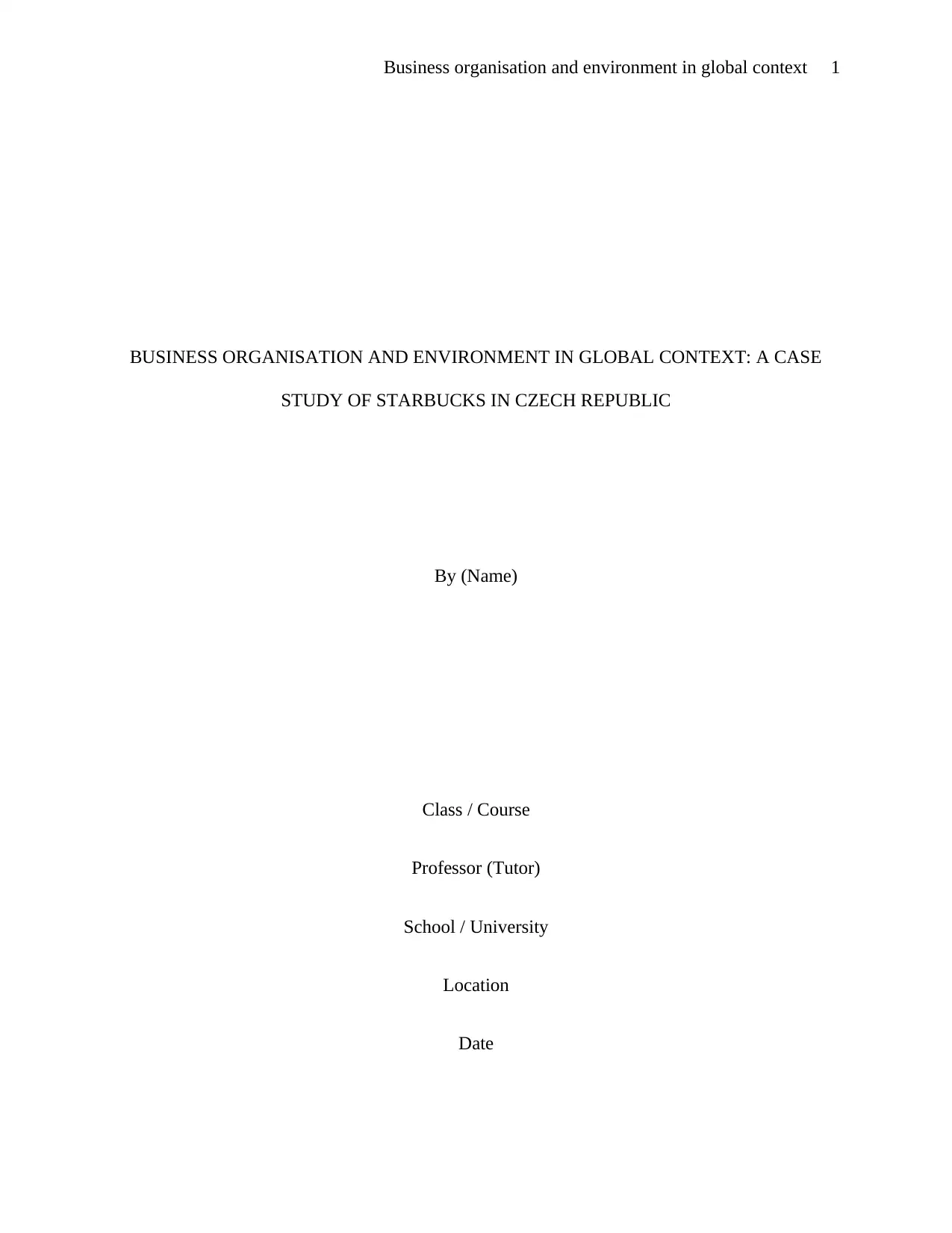
Business organisation and environment in global context 1
BUSINESS ORGANISATION AND ENVIRONMENT IN GLOBAL CONTEXT: A CASE
STUDY OF STARBUCKS IN CZECH REPUBLIC
By (Name)
Class / Course
Professor (Tutor)
School / University
Location
Date
BUSINESS ORGANISATION AND ENVIRONMENT IN GLOBAL CONTEXT: A CASE
STUDY OF STARBUCKS IN CZECH REPUBLIC
By (Name)
Class / Course
Professor (Tutor)
School / University
Location
Date
Paraphrase This Document
Need a fresh take? Get an instant paraphrase of this document with our AI Paraphraser
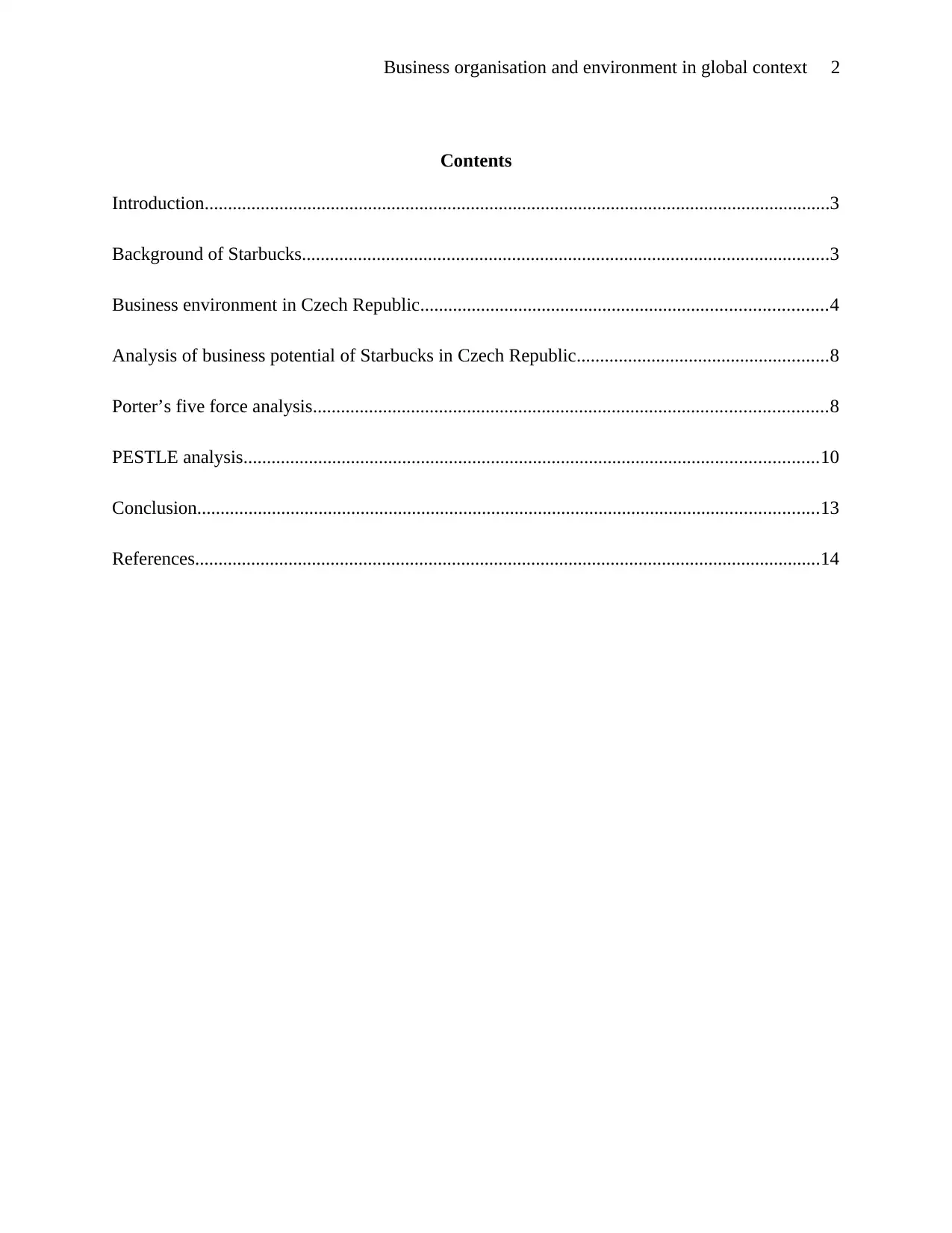
Business organisation and environment in global context 2
Contents
Introduction......................................................................................................................................3
Background of Starbucks.................................................................................................................3
Business environment in Czech Republic.......................................................................................4
Analysis of business potential of Starbucks in Czech Republic......................................................8
Porter’s five force analysis..............................................................................................................8
PESTLE analysis...........................................................................................................................10
Conclusion.....................................................................................................................................13
References......................................................................................................................................14
Contents
Introduction......................................................................................................................................3
Background of Starbucks.................................................................................................................3
Business environment in Czech Republic.......................................................................................4
Analysis of business potential of Starbucks in Czech Republic......................................................8
Porter’s five force analysis..............................................................................................................8
PESTLE analysis...........................................................................................................................10
Conclusion.....................................................................................................................................13
References......................................................................................................................................14
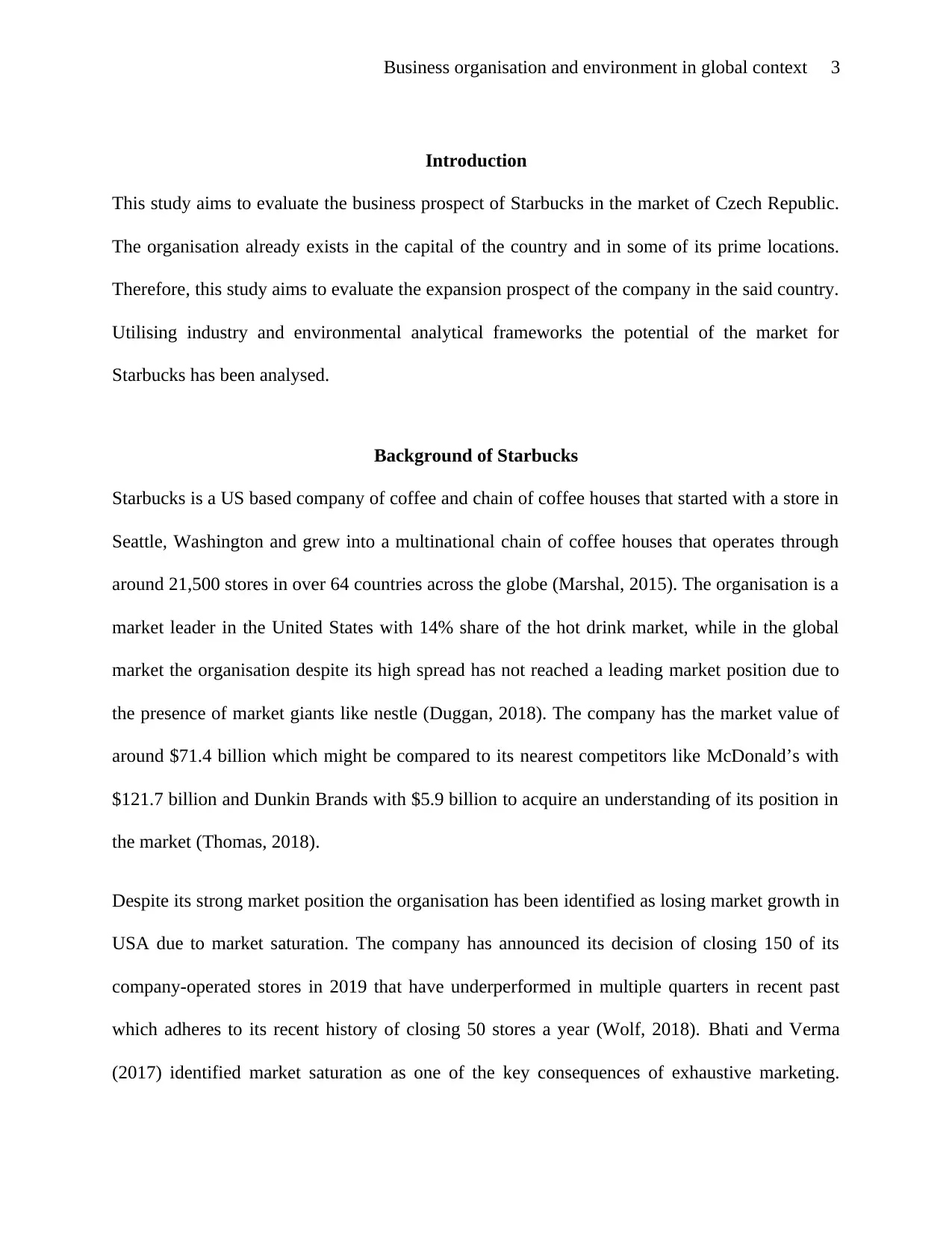
Business organisation and environment in global context 3
Introduction
This study aims to evaluate the business prospect of Starbucks in the market of Czech Republic.
The organisation already exists in the capital of the country and in some of its prime locations.
Therefore, this study aims to evaluate the expansion prospect of the company in the said country.
Utilising industry and environmental analytical frameworks the potential of the market for
Starbucks has been analysed.
Background of Starbucks
Starbucks is a US based company of coffee and chain of coffee houses that started with a store in
Seattle, Washington and grew into a multinational chain of coffee houses that operates through
around 21,500 stores in over 64 countries across the globe (Marshal, 2015). The organisation is a
market leader in the United States with 14% share of the hot drink market, while in the global
market the organisation despite its high spread has not reached a leading market position due to
the presence of market giants like nestle (Duggan, 2018). The company has the market value of
around $71.4 billion which might be compared to its nearest competitors like McDonald’s with
$121.7 billion and Dunkin Brands with $5.9 billion to acquire an understanding of its position in
the market (Thomas, 2018).
Despite its strong market position the organisation has been identified as losing market growth in
USA due to market saturation. The company has announced its decision of closing 150 of its
company-operated stores in 2019 that have underperformed in multiple quarters in recent past
which adheres to its recent history of closing 50 stores a year (Wolf, 2018). Bhati and Verma
(2017) identified market saturation as one of the key consequences of exhaustive marketing.
Introduction
This study aims to evaluate the business prospect of Starbucks in the market of Czech Republic.
The organisation already exists in the capital of the country and in some of its prime locations.
Therefore, this study aims to evaluate the expansion prospect of the company in the said country.
Utilising industry and environmental analytical frameworks the potential of the market for
Starbucks has been analysed.
Background of Starbucks
Starbucks is a US based company of coffee and chain of coffee houses that started with a store in
Seattle, Washington and grew into a multinational chain of coffee houses that operates through
around 21,500 stores in over 64 countries across the globe (Marshal, 2015). The organisation is a
market leader in the United States with 14% share of the hot drink market, while in the global
market the organisation despite its high spread has not reached a leading market position due to
the presence of market giants like nestle (Duggan, 2018). The company has the market value of
around $71.4 billion which might be compared to its nearest competitors like McDonald’s with
$121.7 billion and Dunkin Brands with $5.9 billion to acquire an understanding of its position in
the market (Thomas, 2018).
Despite its strong market position the organisation has been identified as losing market growth in
USA due to market saturation. The company has announced its decision of closing 150 of its
company-operated stores in 2019 that have underperformed in multiple quarters in recent past
which adheres to its recent history of closing 50 stores a year (Wolf, 2018). Bhati and Verma
(2017) identified market saturation as one of the key consequences of exhaustive marketing.
⊘ This is a preview!⊘
Do you want full access?
Subscribe today to unlock all pages.

Trusted by 1+ million students worldwide
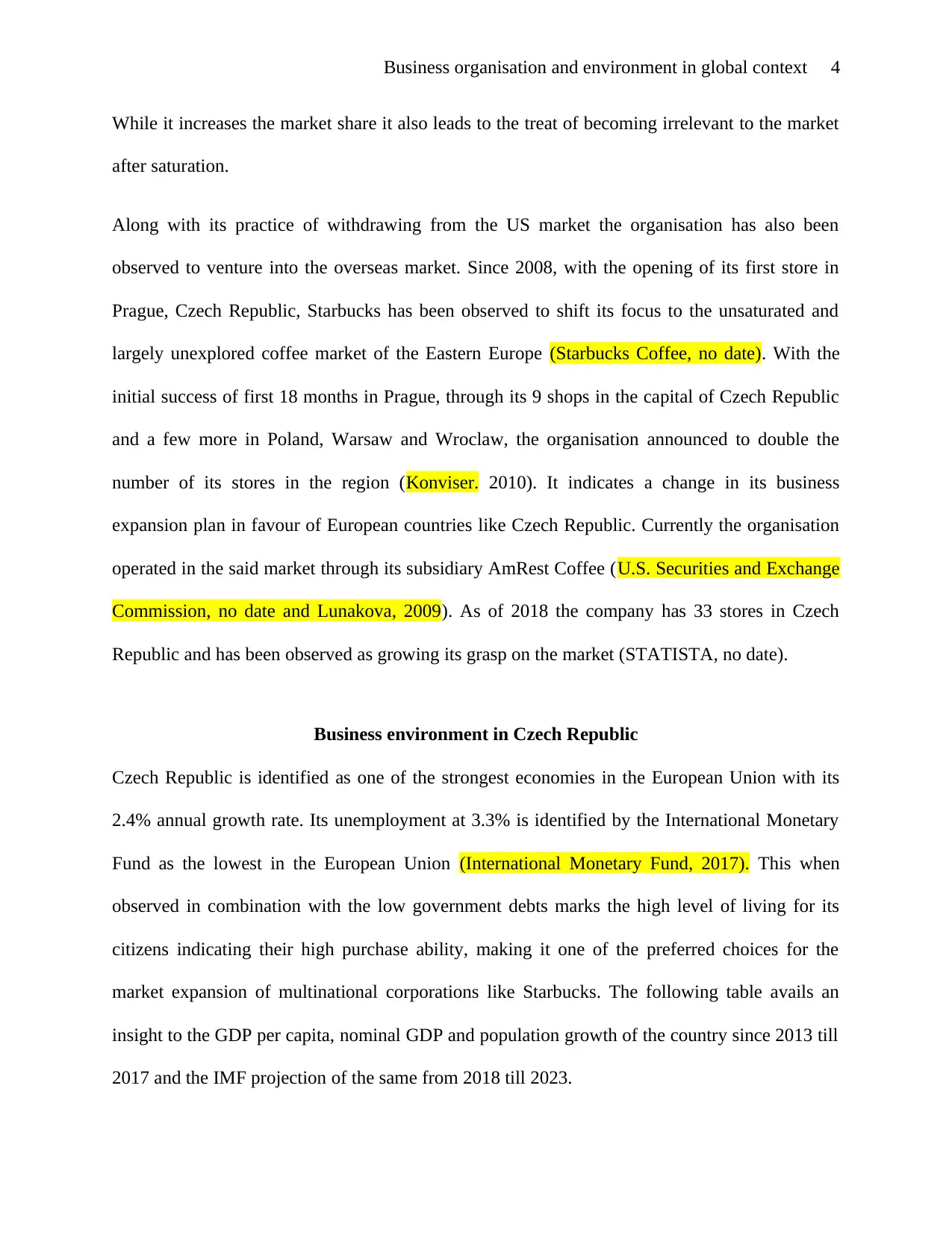
Business organisation and environment in global context 4
While it increases the market share it also leads to the treat of becoming irrelevant to the market
after saturation.
Along with its practice of withdrawing from the US market the organisation has also been
observed to venture into the overseas market. Since 2008, with the opening of its first store in
Prague, Czech Republic, Starbucks has been observed to shift its focus to the unsaturated and
largely unexplored coffee market of the Eastern Europe (Starbucks Coffee, no date). With the
initial success of first 18 months in Prague, through its 9 shops in the capital of Czech Republic
and a few more in Poland, Warsaw and Wroclaw, the organisation announced to double the
number of its stores in the region (Konviser. 2010). It indicates a change in its business
expansion plan in favour of European countries like Czech Republic. Currently the organisation
operated in the said market through its subsidiary AmRest Coffee (U.S. Securities and Exchange
Commission, no date and Lunakova, 2009). As of 2018 the company has 33 stores in Czech
Republic and has been observed as growing its grasp on the market (STATISTA, no date).
Business environment in Czech Republic
Czech Republic is identified as one of the strongest economies in the European Union with its
2.4% annual growth rate. Its unemployment at 3.3% is identified by the International Monetary
Fund as the lowest in the European Union (International Monetary Fund, 2017). This when
observed in combination with the low government debts marks the high level of living for its
citizens indicating their high purchase ability, making it one of the preferred choices for the
market expansion of multinational corporations like Starbucks. The following table avails an
insight to the GDP per capita, nominal GDP and population growth of the country since 2013 till
2017 and the IMF projection of the same from 2018 till 2023.
While it increases the market share it also leads to the treat of becoming irrelevant to the market
after saturation.
Along with its practice of withdrawing from the US market the organisation has also been
observed to venture into the overseas market. Since 2008, with the opening of its first store in
Prague, Czech Republic, Starbucks has been observed to shift its focus to the unsaturated and
largely unexplored coffee market of the Eastern Europe (Starbucks Coffee, no date). With the
initial success of first 18 months in Prague, through its 9 shops in the capital of Czech Republic
and a few more in Poland, Warsaw and Wroclaw, the organisation announced to double the
number of its stores in the region (Konviser. 2010). It indicates a change in its business
expansion plan in favour of European countries like Czech Republic. Currently the organisation
operated in the said market through its subsidiary AmRest Coffee (U.S. Securities and Exchange
Commission, no date and Lunakova, 2009). As of 2018 the company has 33 stores in Czech
Republic and has been observed as growing its grasp on the market (STATISTA, no date).
Business environment in Czech Republic
Czech Republic is identified as one of the strongest economies in the European Union with its
2.4% annual growth rate. Its unemployment at 3.3% is identified by the International Monetary
Fund as the lowest in the European Union (International Monetary Fund, 2017). This when
observed in combination with the low government debts marks the high level of living for its
citizens indicating their high purchase ability, making it one of the preferred choices for the
market expansion of multinational corporations like Starbucks. The following table avails an
insight to the GDP per capita, nominal GDP and population growth of the country since 2013 till
2017 and the IMF projection of the same from 2018 till 2023.
Paraphrase This Document
Need a fresh take? Get an instant paraphrase of this document with our AI Paraphraser
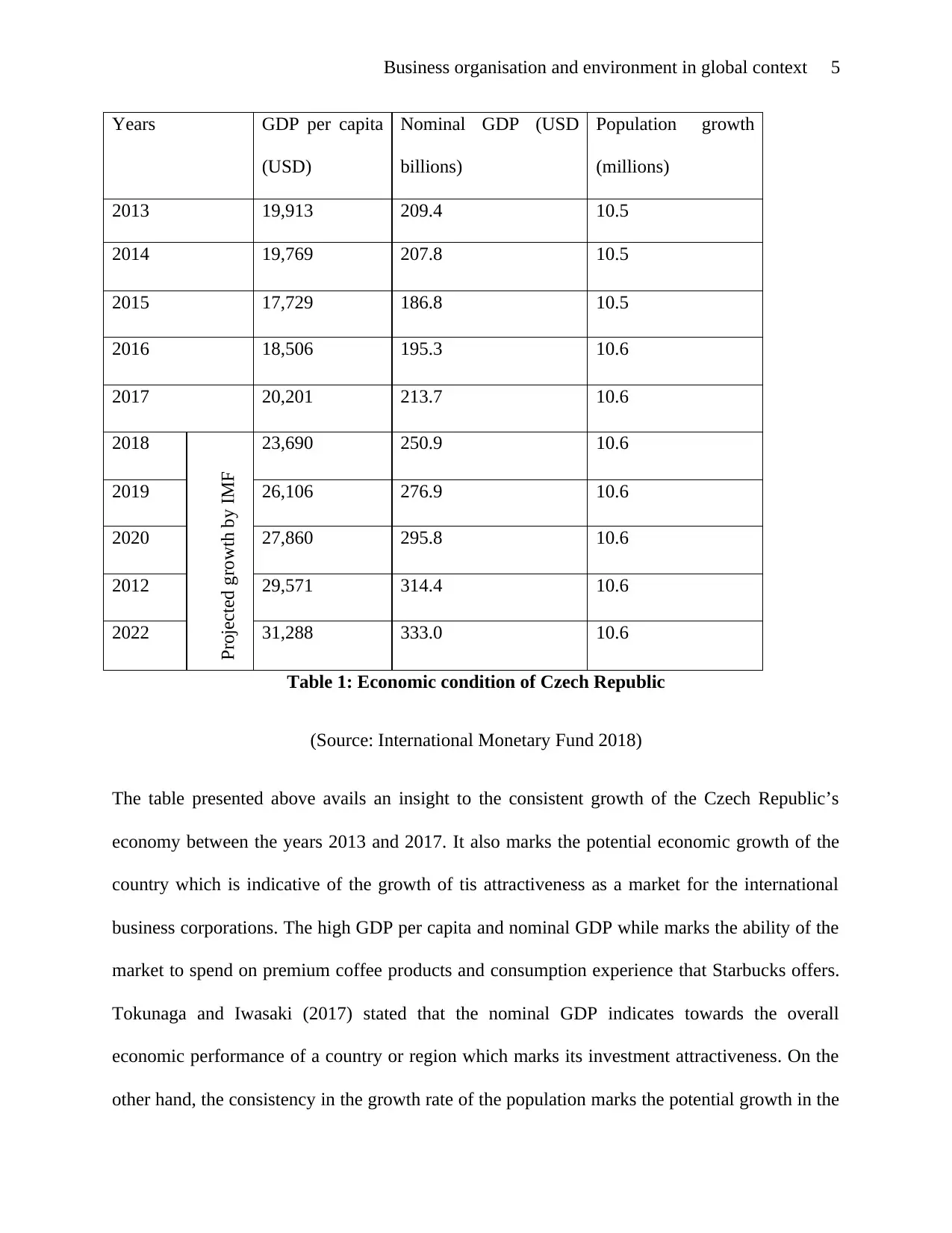
Business organisation and environment in global context 5
Years GDP per capita
(USD)
Nominal GDP (USD
billions)
Population growth
(millions)
2013 19,913 209.4 10.5
2014 19,769 207.8 10.5
2015 17,729 186.8 10.5
2016 18,506 195.3 10.6
2017 20,201 213.7 10.6
2018
Projected growth by IMF
23,690 250.9 10.6
2019 26,106 276.9 10.6
2020 27,860 295.8 10.6
2012 29,571 314.4 10.6
2022 31,288 333.0 10.6
Table 1: Economic condition of Czech Republic
(Source: International Monetary Fund 2018)
The table presented above avails an insight to the consistent growth of the Czech Republic’s
economy between the years 2013 and 2017. It also marks the potential economic growth of the
country which is indicative of the growth of tis attractiveness as a market for the international
business corporations. The high GDP per capita and nominal GDP while marks the ability of the
market to spend on premium coffee products and consumption experience that Starbucks offers.
Tokunaga and Iwasaki (2017) stated that the nominal GDP indicates towards the overall
economic performance of a country or region which marks its investment attractiveness. On the
other hand, the consistency in the growth rate of the population marks the potential growth in the
Years GDP per capita
(USD)
Nominal GDP (USD
billions)
Population growth
(millions)
2013 19,913 209.4 10.5
2014 19,769 207.8 10.5
2015 17,729 186.8 10.5
2016 18,506 195.3 10.6
2017 20,201 213.7 10.6
2018
Projected growth by IMF
23,690 250.9 10.6
2019 26,106 276.9 10.6
2020 27,860 295.8 10.6
2012 29,571 314.4 10.6
2022 31,288 333.0 10.6
Table 1: Economic condition of Czech Republic
(Source: International Monetary Fund 2018)
The table presented above avails an insight to the consistent growth of the Czech Republic’s
economy between the years 2013 and 2017. It also marks the potential economic growth of the
country which is indicative of the growth of tis attractiveness as a market for the international
business corporations. The high GDP per capita and nominal GDP while marks the ability of the
market to spend on premium coffee products and consumption experience that Starbucks offers.
Tokunaga and Iwasaki (2017) stated that the nominal GDP indicates towards the overall
economic performance of a country or region which marks its investment attractiveness. On the
other hand, the consistency in the growth rate of the population marks the potential growth in the
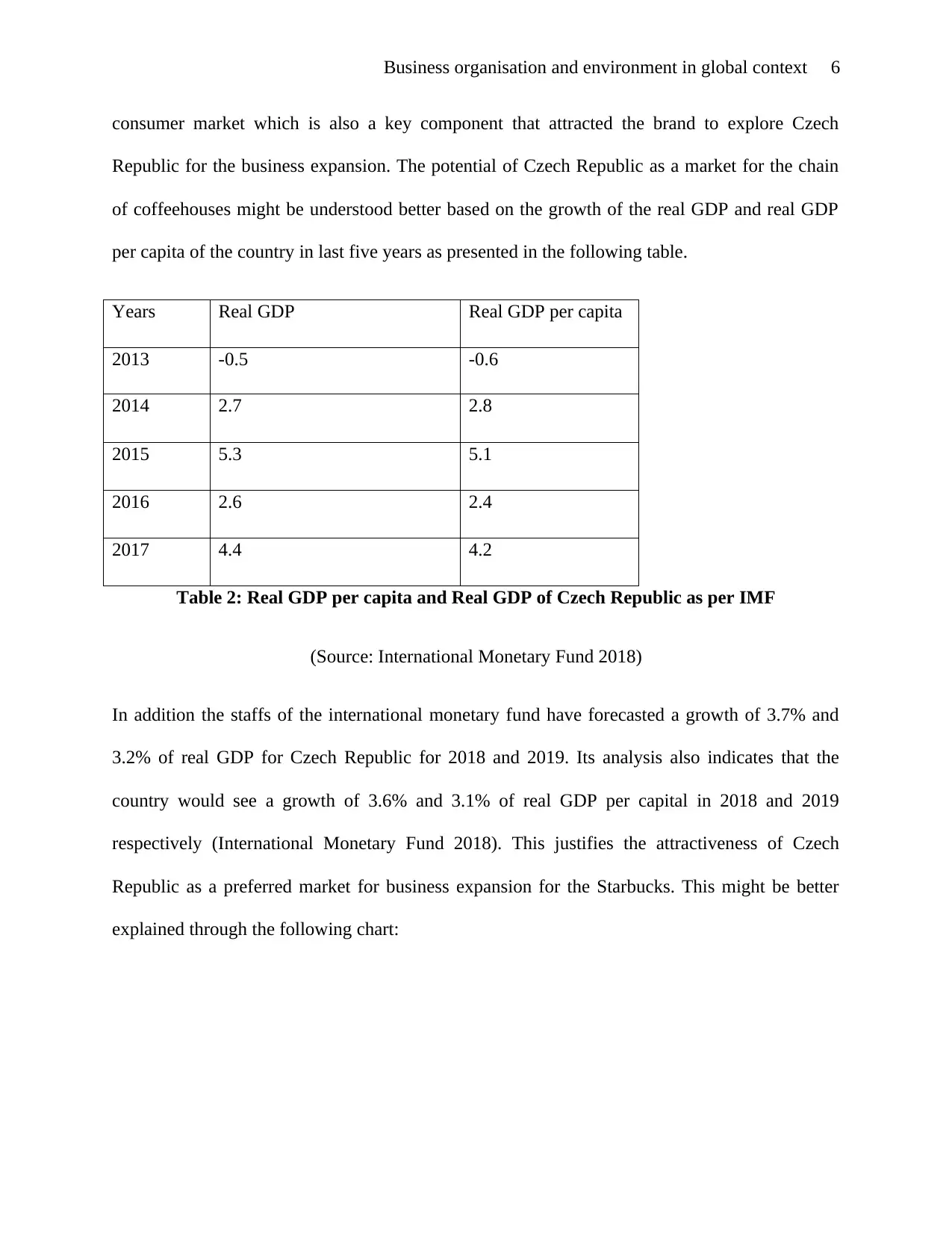
Business organisation and environment in global context 6
consumer market which is also a key component that attracted the brand to explore Czech
Republic for the business expansion. The potential of Czech Republic as a market for the chain
of coffeehouses might be understood better based on the growth of the real GDP and real GDP
per capita of the country in last five years as presented in the following table.
Years Real GDP Real GDP per capita
2013 -0.5 -0.6
2014 2.7 2.8
2015 5.3 5.1
2016 2.6 2.4
2017 4.4 4.2
Table 2: Real GDP per capita and Real GDP of Czech Republic as per IMF
(Source: International Monetary Fund 2018)
In addition the staffs of the international monetary fund have forecasted a growth of 3.7% and
3.2% of real GDP for Czech Republic for 2018 and 2019. Its analysis also indicates that the
country would see a growth of 3.6% and 3.1% of real GDP per capital in 2018 and 2019
respectively (International Monetary Fund 2018). This justifies the attractiveness of Czech
Republic as a preferred market for business expansion for the Starbucks. This might be better
explained through the following chart:
consumer market which is also a key component that attracted the brand to explore Czech
Republic for the business expansion. The potential of Czech Republic as a market for the chain
of coffeehouses might be understood better based on the growth of the real GDP and real GDP
per capita of the country in last five years as presented in the following table.
Years Real GDP Real GDP per capita
2013 -0.5 -0.6
2014 2.7 2.8
2015 5.3 5.1
2016 2.6 2.4
2017 4.4 4.2
Table 2: Real GDP per capita and Real GDP of Czech Republic as per IMF
(Source: International Monetary Fund 2018)
In addition the staffs of the international monetary fund have forecasted a growth of 3.7% and
3.2% of real GDP for Czech Republic for 2018 and 2019. Its analysis also indicates that the
country would see a growth of 3.6% and 3.1% of real GDP per capital in 2018 and 2019
respectively (International Monetary Fund 2018). This justifies the attractiveness of Czech
Republic as a preferred market for business expansion for the Starbucks. This might be better
explained through the following chart:
⊘ This is a preview!⊘
Do you want full access?
Subscribe today to unlock all pages.

Trusted by 1+ million students worldwide
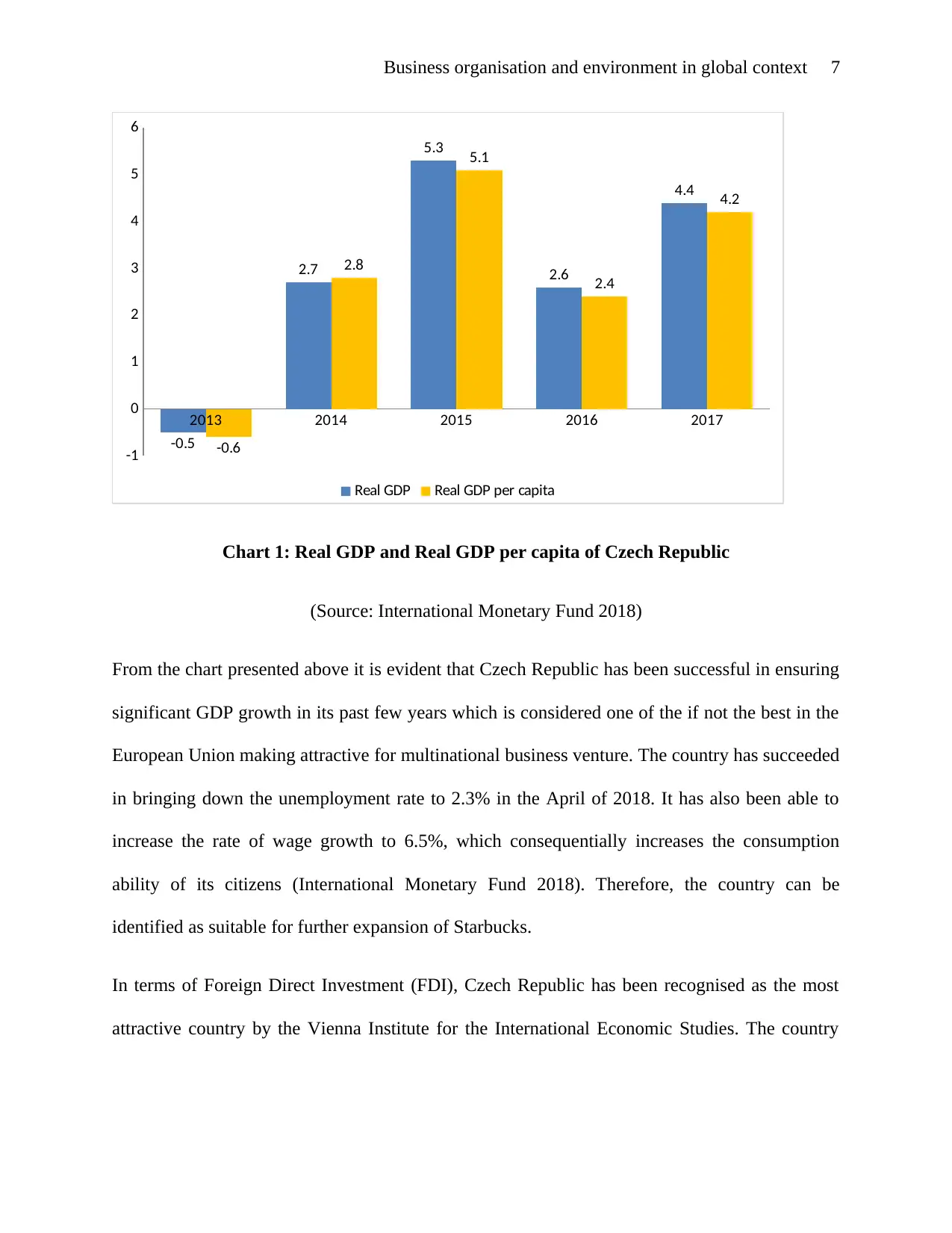
Business organisation and environment in global context 7
2013 2014 2015 2016 2017
-1
0
1
2
3
4
5
6
-0.5
2.7
5.3
2.6
4.4
-0.6
2.8
5.1
2.4
4.2
Real GDP Real GDP per capita
Chart 1: Real GDP and Real GDP per capita of Czech Republic
(Source: International Monetary Fund 2018)
From the chart presented above it is evident that Czech Republic has been successful in ensuring
significant GDP growth in its past few years which is considered one of the if not the best in the
European Union making attractive for multinational business venture. The country has succeeded
in bringing down the unemployment rate to 2.3% in the April of 2018. It has also been able to
increase the rate of wage growth to 6.5%, which consequentially increases the consumption
ability of its citizens (International Monetary Fund 2018). Therefore, the country can be
identified as suitable for further expansion of Starbucks.
In terms of Foreign Direct Investment (FDI), Czech Republic has been recognised as the most
attractive country by the Vienna Institute for the International Economic Studies. The country
2013 2014 2015 2016 2017
-1
0
1
2
3
4
5
6
-0.5
2.7
5.3
2.6
4.4
-0.6
2.8
5.1
2.4
4.2
Real GDP Real GDP per capita
Chart 1: Real GDP and Real GDP per capita of Czech Republic
(Source: International Monetary Fund 2018)
From the chart presented above it is evident that Czech Republic has been successful in ensuring
significant GDP growth in its past few years which is considered one of the if not the best in the
European Union making attractive for multinational business venture. The country has succeeded
in bringing down the unemployment rate to 2.3% in the April of 2018. It has also been able to
increase the rate of wage growth to 6.5%, which consequentially increases the consumption
ability of its citizens (International Monetary Fund 2018). Therefore, the country can be
identified as suitable for further expansion of Starbucks.
In terms of Foreign Direct Investment (FDI), Czech Republic has been recognised as the most
attractive country by the Vienna Institute for the International Economic Studies. The country
Paraphrase This Document
Need a fresh take? Get an instant paraphrase of this document with our AI Paraphraser
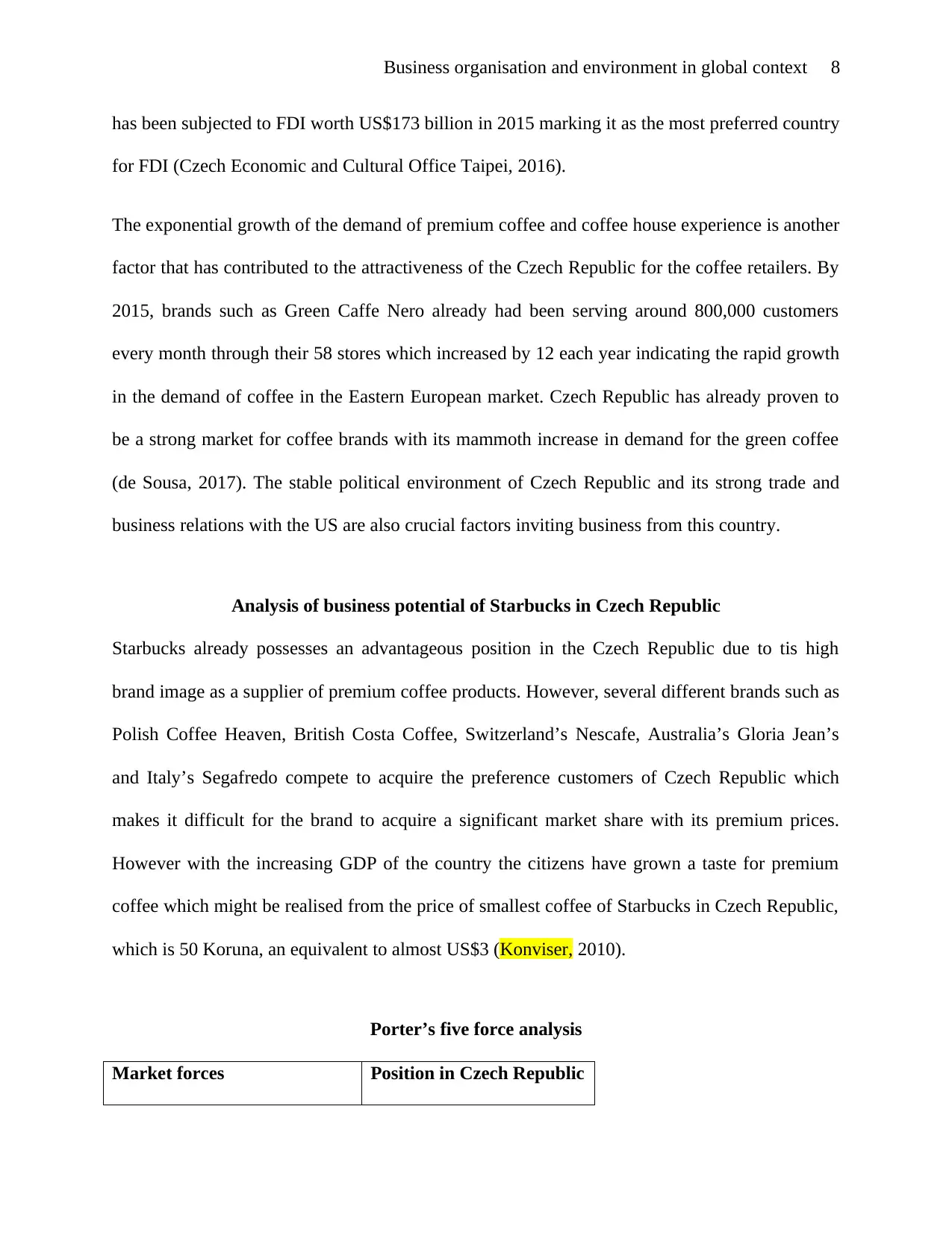
Business organisation and environment in global context 8
has been subjected to FDI worth US$173 billion in 2015 marking it as the most preferred country
for FDI (Czech Economic and Cultural Office Taipei, 2016).
The exponential growth of the demand of premium coffee and coffee house experience is another
factor that has contributed to the attractiveness of the Czech Republic for the coffee retailers. By
2015, brands such as Green Caffe Nero already had been serving around 800,000 customers
every month through their 58 stores which increased by 12 each year indicating the rapid growth
in the demand of coffee in the Eastern European market. Czech Republic has already proven to
be a strong market for coffee brands with its mammoth increase in demand for the green coffee
(de Sousa, 2017). The stable political environment of Czech Republic and its strong trade and
business relations with the US are also crucial factors inviting business from this country.
Analysis of business potential of Starbucks in Czech Republic
Starbucks already possesses an advantageous position in the Czech Republic due to tis high
brand image as a supplier of premium coffee products. However, several different brands such as
Polish Coffee Heaven, British Costa Coffee, Switzerland’s Nescafe, Australia’s Gloria Jean’s
and Italy’s Segafredo compete to acquire the preference customers of Czech Republic which
makes it difficult for the brand to acquire a significant market share with its premium prices.
However with the increasing GDP of the country the citizens have grown a taste for premium
coffee which might be realised from the price of smallest coffee of Starbucks in Czech Republic,
which is 50 Koruna, an equivalent to almost US$3 (Konviser, 2010).
Porter’s five force analysis
Market forces Position in Czech Republic
has been subjected to FDI worth US$173 billion in 2015 marking it as the most preferred country
for FDI (Czech Economic and Cultural Office Taipei, 2016).
The exponential growth of the demand of premium coffee and coffee house experience is another
factor that has contributed to the attractiveness of the Czech Republic for the coffee retailers. By
2015, brands such as Green Caffe Nero already had been serving around 800,000 customers
every month through their 58 stores which increased by 12 each year indicating the rapid growth
in the demand of coffee in the Eastern European market. Czech Republic has already proven to
be a strong market for coffee brands with its mammoth increase in demand for the green coffee
(de Sousa, 2017). The stable political environment of Czech Republic and its strong trade and
business relations with the US are also crucial factors inviting business from this country.
Analysis of business potential of Starbucks in Czech Republic
Starbucks already possesses an advantageous position in the Czech Republic due to tis high
brand image as a supplier of premium coffee products. However, several different brands such as
Polish Coffee Heaven, British Costa Coffee, Switzerland’s Nescafe, Australia’s Gloria Jean’s
and Italy’s Segafredo compete to acquire the preference customers of Czech Republic which
makes it difficult for the brand to acquire a significant market share with its premium prices.
However with the increasing GDP of the country the citizens have grown a taste for premium
coffee which might be realised from the price of smallest coffee of Starbucks in Czech Republic,
which is 50 Koruna, an equivalent to almost US$3 (Konviser, 2010).
Porter’s five force analysis
Market forces Position in Czech Republic
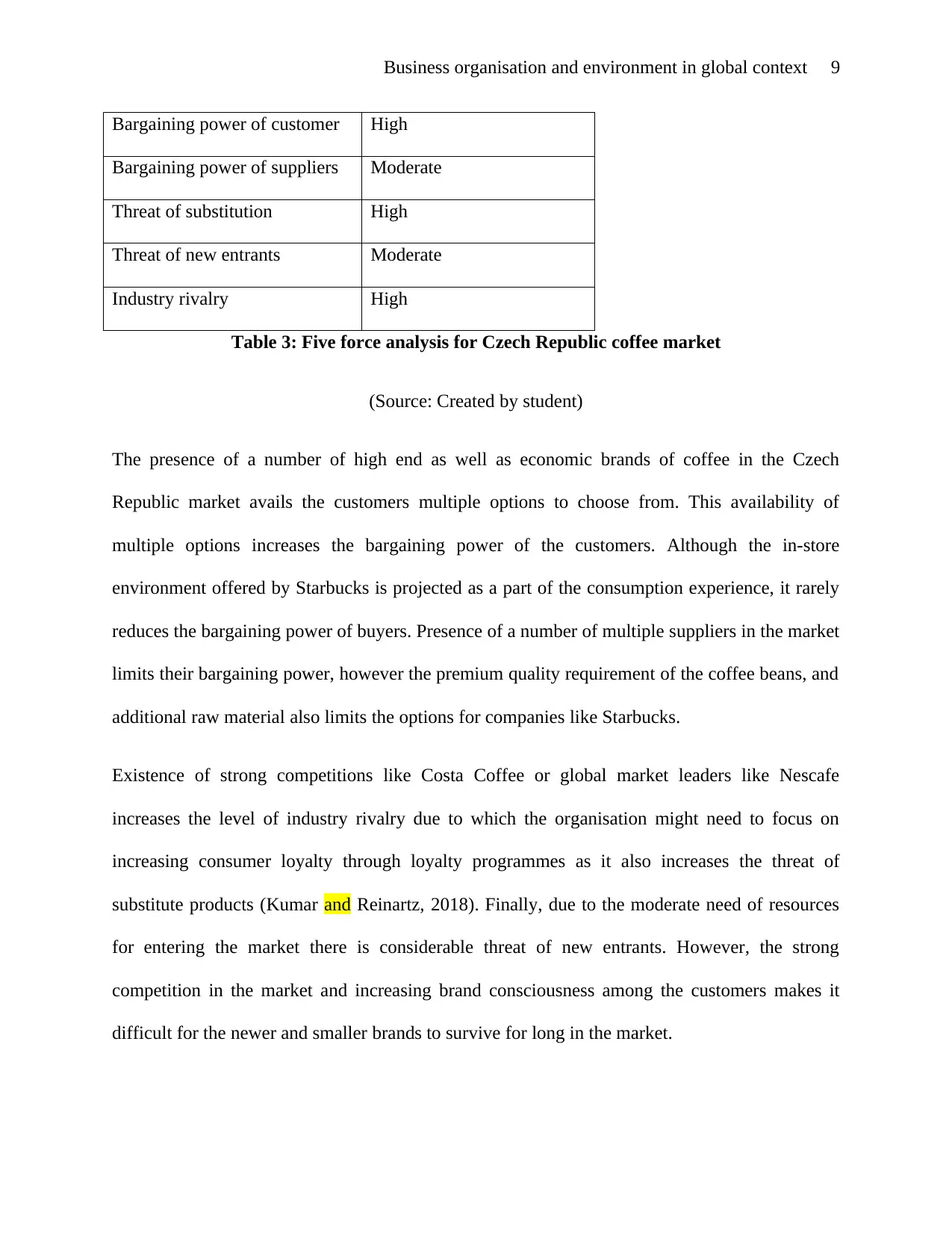
Business organisation and environment in global context 9
Bargaining power of customer High
Bargaining power of suppliers Moderate
Threat of substitution High
Threat of new entrants Moderate
Industry rivalry High
Table 3: Five force analysis for Czech Republic coffee market
(Source: Created by student)
The presence of a number of high end as well as economic brands of coffee in the Czech
Republic market avails the customers multiple options to choose from. This availability of
multiple options increases the bargaining power of the customers. Although the in-store
environment offered by Starbucks is projected as a part of the consumption experience, it rarely
reduces the bargaining power of buyers. Presence of a number of multiple suppliers in the market
limits their bargaining power, however the premium quality requirement of the coffee beans, and
additional raw material also limits the options for companies like Starbucks.
Existence of strong competitions like Costa Coffee or global market leaders like Nescafe
increases the level of industry rivalry due to which the organisation might need to focus on
increasing consumer loyalty through loyalty programmes as it also increases the threat of
substitute products (Kumar and Reinartz, 2018). Finally, due to the moderate need of resources
for entering the market there is considerable threat of new entrants. However, the strong
competition in the market and increasing brand consciousness among the customers makes it
difficult for the newer and smaller brands to survive for long in the market.
Bargaining power of customer High
Bargaining power of suppliers Moderate
Threat of substitution High
Threat of new entrants Moderate
Industry rivalry High
Table 3: Five force analysis for Czech Republic coffee market
(Source: Created by student)
The presence of a number of high end as well as economic brands of coffee in the Czech
Republic market avails the customers multiple options to choose from. This availability of
multiple options increases the bargaining power of the customers. Although the in-store
environment offered by Starbucks is projected as a part of the consumption experience, it rarely
reduces the bargaining power of buyers. Presence of a number of multiple suppliers in the market
limits their bargaining power, however the premium quality requirement of the coffee beans, and
additional raw material also limits the options for companies like Starbucks.
Existence of strong competitions like Costa Coffee or global market leaders like Nescafe
increases the level of industry rivalry due to which the organisation might need to focus on
increasing consumer loyalty through loyalty programmes as it also increases the threat of
substitute products (Kumar and Reinartz, 2018). Finally, due to the moderate need of resources
for entering the market there is considerable threat of new entrants. However, the strong
competition in the market and increasing brand consciousness among the customers makes it
difficult for the newer and smaller brands to survive for long in the market.
⊘ This is a preview!⊘
Do you want full access?
Subscribe today to unlock all pages.

Trusted by 1+ million students worldwide
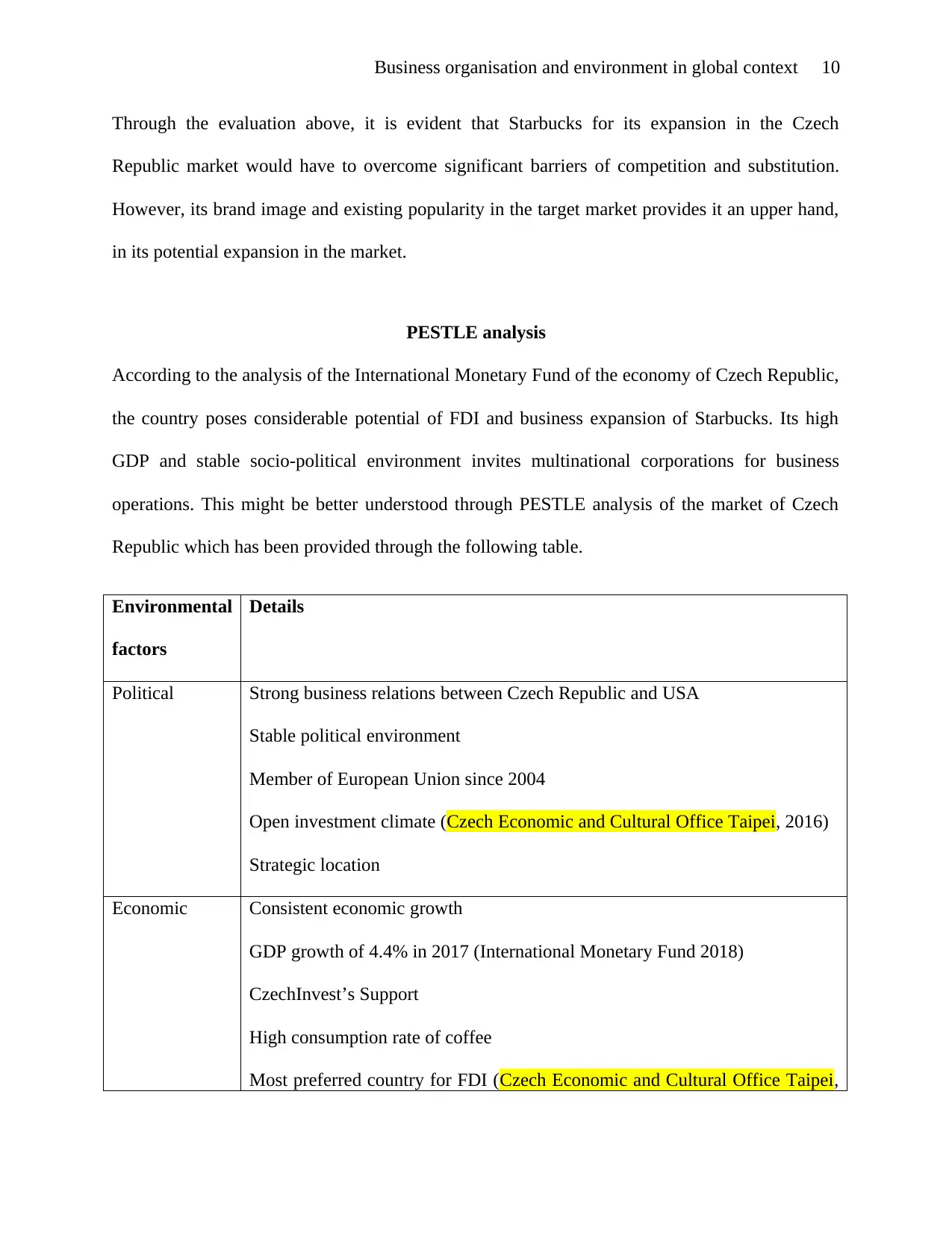
Business organisation and environment in global context 10
Through the evaluation above, it is evident that Starbucks for its expansion in the Czech
Republic market would have to overcome significant barriers of competition and substitution.
However, its brand image and existing popularity in the target market provides it an upper hand,
in its potential expansion in the market.
PESTLE analysis
According to the analysis of the International Monetary Fund of the economy of Czech Republic,
the country poses considerable potential of FDI and business expansion of Starbucks. Its high
GDP and stable socio-political environment invites multinational corporations for business
operations. This might be better understood through PESTLE analysis of the market of Czech
Republic which has been provided through the following table.
Environmental
factors
Details
Political Strong business relations between Czech Republic and USA
Stable political environment
Member of European Union since 2004
Open investment climate (Czech Economic and Cultural Office Taipei, 2016)
Strategic location
Economic Consistent economic growth
GDP growth of 4.4% in 2017 (International Monetary Fund 2018)
CzechInvest’s Support
High consumption rate of coffee
Most preferred country for FDI (Czech Economic and Cultural Office Taipei,
Through the evaluation above, it is evident that Starbucks for its expansion in the Czech
Republic market would have to overcome significant barriers of competition and substitution.
However, its brand image and existing popularity in the target market provides it an upper hand,
in its potential expansion in the market.
PESTLE analysis
According to the analysis of the International Monetary Fund of the economy of Czech Republic,
the country poses considerable potential of FDI and business expansion of Starbucks. Its high
GDP and stable socio-political environment invites multinational corporations for business
operations. This might be better understood through PESTLE analysis of the market of Czech
Republic which has been provided through the following table.
Environmental
factors
Details
Political Strong business relations between Czech Republic and USA
Stable political environment
Member of European Union since 2004
Open investment climate (Czech Economic and Cultural Office Taipei, 2016)
Strategic location
Economic Consistent economic growth
GDP growth of 4.4% in 2017 (International Monetary Fund 2018)
CzechInvest’s Support
High consumption rate of coffee
Most preferred country for FDI (Czech Economic and Cultural Office Taipei,
Paraphrase This Document
Need a fresh take? Get an instant paraphrase of this document with our AI Paraphraser
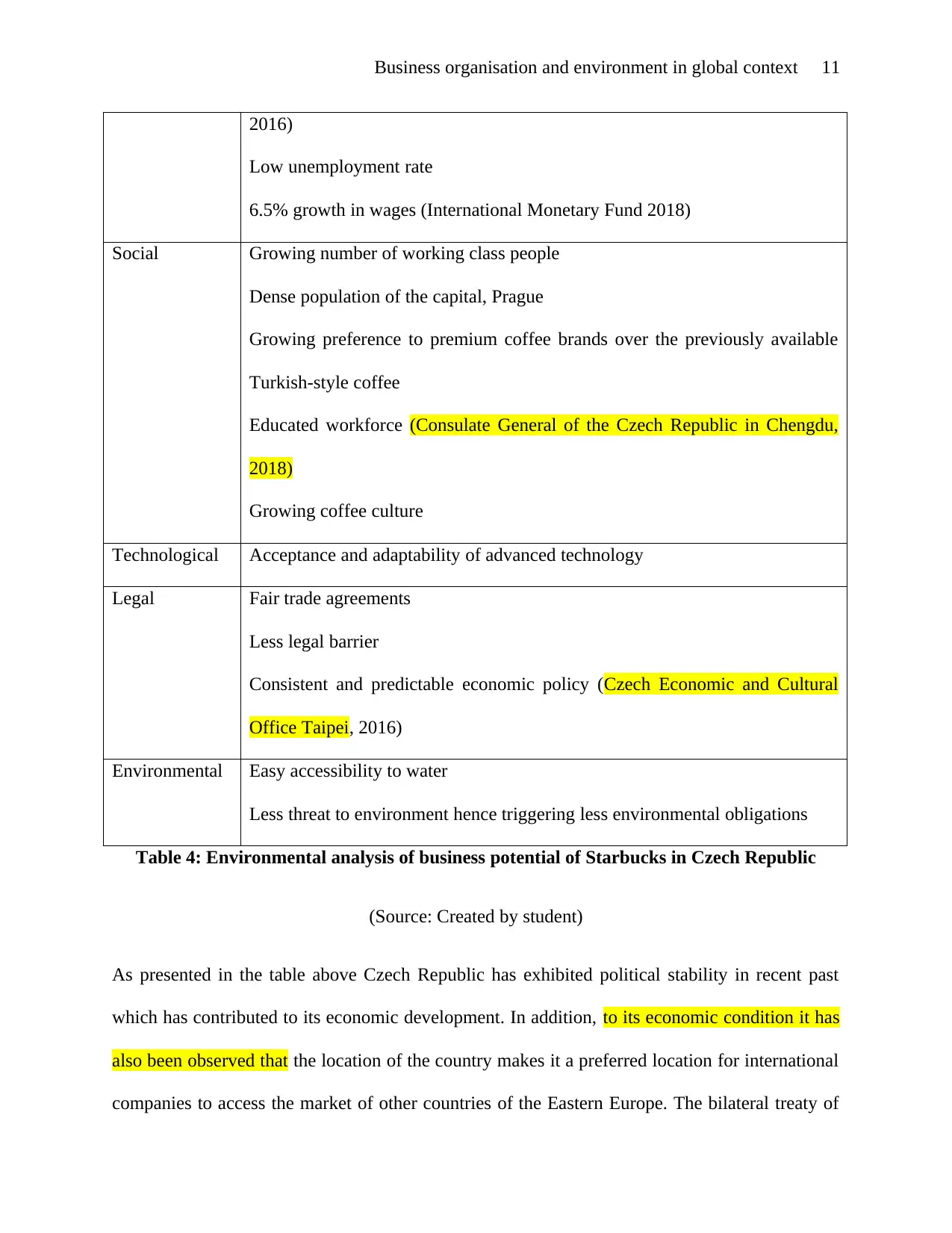
Business organisation and environment in global context 11
2016)
Low unemployment rate
6.5% growth in wages (International Monetary Fund 2018)
Social Growing number of working class people
Dense population of the capital, Prague
Growing preference to premium coffee brands over the previously available
Turkish-style coffee
Educated workforce (Consulate General of the Czech Republic in Chengdu,
2018)
Growing coffee culture
Technological Acceptance and adaptability of advanced technology
Legal Fair trade agreements
Less legal barrier
Consistent and predictable economic policy (Czech Economic and Cultural
Office Taipei, 2016)
Environmental Easy accessibility to water
Less threat to environment hence triggering less environmental obligations
Table 4: Environmental analysis of business potential of Starbucks in Czech Republic
(Source: Created by student)
As presented in the table above Czech Republic has exhibited political stability in recent past
which has contributed to its economic development. In addition, to its economic condition it has
also been observed that the location of the country makes it a preferred location for international
companies to access the market of other countries of the Eastern Europe. The bilateral treaty of
2016)
Low unemployment rate
6.5% growth in wages (International Monetary Fund 2018)
Social Growing number of working class people
Dense population of the capital, Prague
Growing preference to premium coffee brands over the previously available
Turkish-style coffee
Educated workforce (Consulate General of the Czech Republic in Chengdu,
2018)
Growing coffee culture
Technological Acceptance and adaptability of advanced technology
Legal Fair trade agreements
Less legal barrier
Consistent and predictable economic policy (Czech Economic and Cultural
Office Taipei, 2016)
Environmental Easy accessibility to water
Less threat to environment hence triggering less environmental obligations
Table 4: Environmental analysis of business potential of Starbucks in Czech Republic
(Source: Created by student)
As presented in the table above Czech Republic has exhibited political stability in recent past
which has contributed to its economic development. In addition, to its economic condition it has
also been observed that the location of the country makes it a preferred location for international
companies to access the market of other countries of the Eastern Europe. The bilateral treaty of
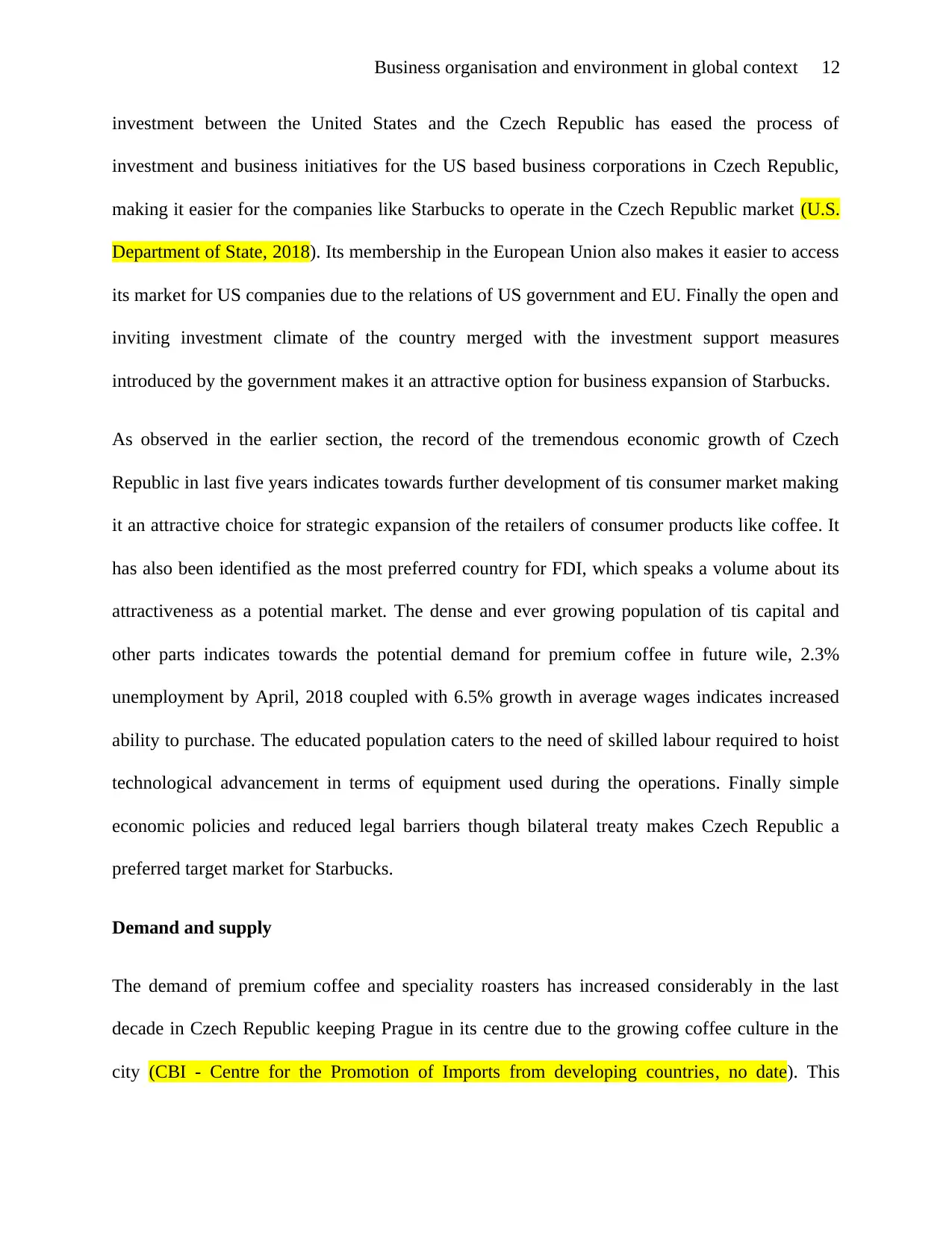
Business organisation and environment in global context 12
investment between the United States and the Czech Republic has eased the process of
investment and business initiatives for the US based business corporations in Czech Republic,
making it easier for the companies like Starbucks to operate in the Czech Republic market (U.S.
Department of State, 2018). Its membership in the European Union also makes it easier to access
its market for US companies due to the relations of US government and EU. Finally the open and
inviting investment climate of the country merged with the investment support measures
introduced by the government makes it an attractive option for business expansion of Starbucks.
As observed in the earlier section, the record of the tremendous economic growth of Czech
Republic in last five years indicates towards further development of tis consumer market making
it an attractive choice for strategic expansion of the retailers of consumer products like coffee. It
has also been identified as the most preferred country for FDI, which speaks a volume about its
attractiveness as a potential market. The dense and ever growing population of tis capital and
other parts indicates towards the potential demand for premium coffee in future wile, 2.3%
unemployment by April, 2018 coupled with 6.5% growth in average wages indicates increased
ability to purchase. The educated population caters to the need of skilled labour required to hoist
technological advancement in terms of equipment used during the operations. Finally simple
economic policies and reduced legal barriers though bilateral treaty makes Czech Republic a
preferred target market for Starbucks.
Demand and supply
The demand of premium coffee and speciality roasters has increased considerably in the last
decade in Czech Republic keeping Prague in its centre due to the growing coffee culture in the
city (CBI - Centre for the Promotion of Imports from developing countries, no date). This
investment between the United States and the Czech Republic has eased the process of
investment and business initiatives for the US based business corporations in Czech Republic,
making it easier for the companies like Starbucks to operate in the Czech Republic market (U.S.
Department of State, 2018). Its membership in the European Union also makes it easier to access
its market for US companies due to the relations of US government and EU. Finally the open and
inviting investment climate of the country merged with the investment support measures
introduced by the government makes it an attractive option for business expansion of Starbucks.
As observed in the earlier section, the record of the tremendous economic growth of Czech
Republic in last five years indicates towards further development of tis consumer market making
it an attractive choice for strategic expansion of the retailers of consumer products like coffee. It
has also been identified as the most preferred country for FDI, which speaks a volume about its
attractiveness as a potential market. The dense and ever growing population of tis capital and
other parts indicates towards the potential demand for premium coffee in future wile, 2.3%
unemployment by April, 2018 coupled with 6.5% growth in average wages indicates increased
ability to purchase. The educated population caters to the need of skilled labour required to hoist
technological advancement in terms of equipment used during the operations. Finally simple
economic policies and reduced legal barriers though bilateral treaty makes Czech Republic a
preferred target market for Starbucks.
Demand and supply
The demand of premium coffee and speciality roasters has increased considerably in the last
decade in Czech Republic keeping Prague in its centre due to the growing coffee culture in the
city (CBI - Centre for the Promotion of Imports from developing countries, no date). This
⊘ This is a preview!⊘
Do you want full access?
Subscribe today to unlock all pages.

Trusted by 1+ million students worldwide
1 out of 17
Related Documents
Your All-in-One AI-Powered Toolkit for Academic Success.
+13062052269
info@desklib.com
Available 24*7 on WhatsApp / Email
![[object Object]](/_next/static/media/star-bottom.7253800d.svg)
Unlock your academic potential
Copyright © 2020–2025 A2Z Services. All Rights Reserved. Developed and managed by ZUCOL.





